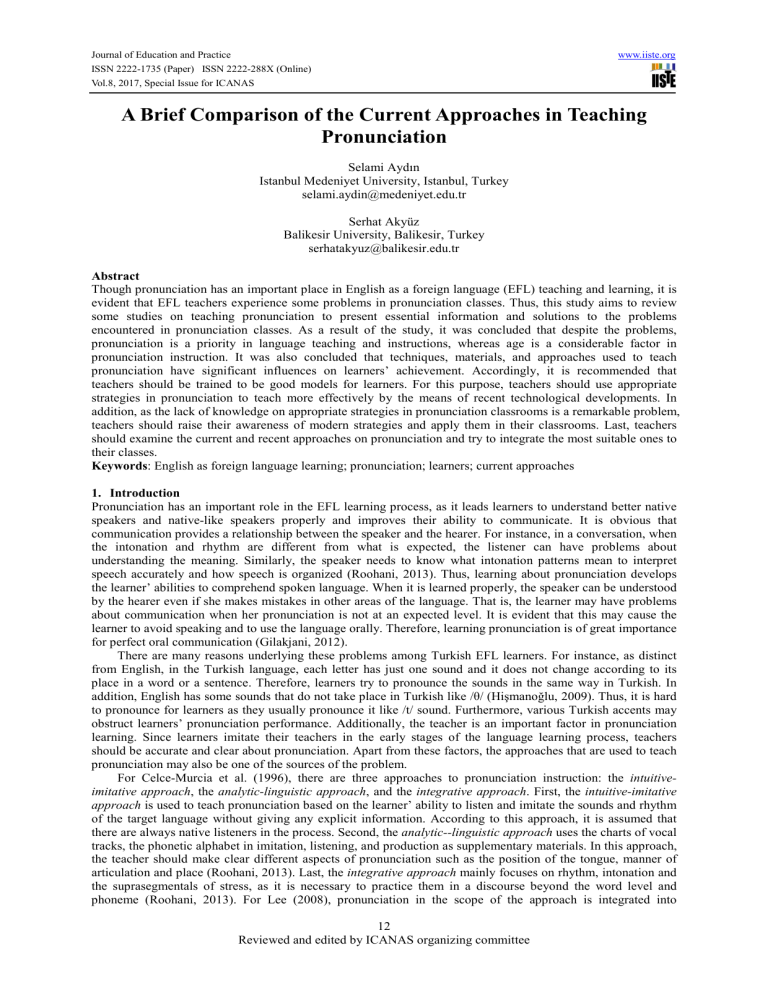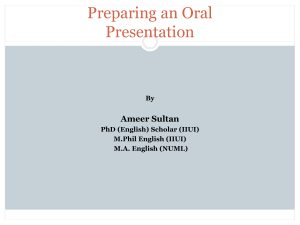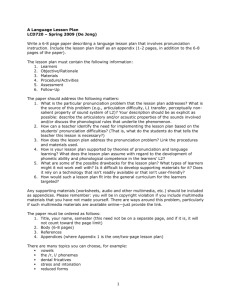
Journal of Education and Practice ISSN 2222-1735 (Paper) ISSN 2222-288X (Online) Vol.8, 2017, Special Issue for ICANAS www.iiste.org A Brief Comparison of the Current Approaches in Teaching Pronunciation Selami Aydın Istanbul Medeniyet University, Istanbul, Turkey selami.aydin@medeniyet.edu.tr Serhat Akyüz Balikesir University, Balikesir, Turkey serhatakyuz@balikesir.edu.tr Abstract Though pronunciation has an important place in English as a foreign language (EFL) teaching and learning, it is evident that EFL teachers experience some problems in pronunciation classes. Thus, this study aims to review some studies on teaching pronunciation to present essential information and solutions to the problems encountered in pronunciation classes. As a result of the study, it was concluded that despite the problems, pronunciation is a priority in language teaching and instructions, whereas age is a considerable factor in pronunciation instruction. It was also concluded that techniques, materials, and approaches used to teach pronunciation have significant influences on learners’ achievement. Accordingly, it is recommended that teachers should be trained to be good models for learners. For this purpose, teachers should use appropriate strategies in pronunciation to teach more effectively by the means of recent technological developments. In addition, as the lack of knowledge on appropriate strategies in pronunciation classrooms is a remarkable problem, teachers should raise their awareness of modern strategies and apply them in their classrooms. Last, teachers should examine the current and recent approaches on pronunciation and try to integrate the most suitable ones to their classes. Keywords: English as foreign language learning; pronunciation; learners; current approaches 1. Introduction Pronunciation has an important role in the EFL learning process, as it leads learners to understand better native speakers and native-like speakers properly and improves their ability to communicate. It is obvious that communication provides a relationship between the speaker and the hearer. For instance, in a conversation, when the intonation and rhythm are different from what is expected, the listener can have problems about understanding the meaning. Similarly, the speaker needs to know what intonation patterns mean to interpret speech accurately and how speech is organized (Roohani, 2013). Thus, learning about pronunciation develops the learner’ abilities to comprehend spoken language. When it is learned properly, the speaker can be understood by the hearer even if she makes mistakes in other areas of the language. That is, the learner may have problems about communication when her pronunciation is not at an expected level. It is evident that this may cause the learner to avoid speaking and to use the language orally. Therefore, learning pronunciation is of great importance for perfect oral communication (Gilakjani, 2012). There are many reasons underlying these problems among Turkish EFL learners. For instance, as distinct from English, in the Turkish language, each letter has just one sound and it does not change according to its place in a word or a sentence. Therefore, learners try to pronounce the sounds in the same way in Turkish. In addition, English has some sounds that do not take place in Turkish like /θ/ (Hişmanoğlu, 2009). Thus, it is hard to pronounce for learners as they usually pronounce it like /t/ sound. Furthermore, various Turkish accents may obstruct learners’ pronunciation performance. Additionally, the teacher is an important factor in pronunciation learning. Since learners imitate their teachers in the early stages of the language learning process, teachers should be accurate and clear about pronunciation. Apart from these factors, the approaches that are used to teach pronunciation may also be one of the sources of the problem. For Celce-Murcia et al. (1996), there are three approaches to pronunciation instruction: the intuitiveimitative approach, the analytic-linguistic approach, and the integrative approach. First, the intuitive-imitative approach is used to teach pronunciation based on the learner’ ability to listen and imitate the sounds and rhythm of the target language without giving any explicit information. According to this approach, it is assumed that there are always native listeners in the process. Second, the analytic--linguistic approach uses the charts of vocal tracks, the phonetic alphabet in imitation, listening, and production as supplementary materials. In this approach, the teacher should make clear different aspects of pronunciation such as the position of the tongue, manner of articulation and place (Roohani, 2013). Last, the integrative approach mainly focuses on rhythm, intonation and the suprasegmentals of stress, as it is necessary to practice them in a discourse beyond the word level and phoneme (Roohani, 2013). For Lee (2008), pronunciation in the scope of the approach is integrated into 12 Reviewed and edited by ICANAS organizing committee Journal of Education and Practice ISSN 2222-1735 (Paper) ISSN 2222-288X (Online) Vol.8, 2017, Special Issue for ICANAS www.iiste.org meaningful task-based activities. In other words, pronunciation is considered as an integral component of communication rather than an isolated drill (p.1). Thus, pronunciation is practiced in meaningful task-based activities that may facilitate learning pronunciation. In the scope of this approach, Morley (1994) states that pronunciation teaching aims to develop intelligible speech and to communicate in the target language. To sum up, in the intuitive-imitative approach, technological devices (such as videotapes, web sites) are used to facilitate learning, whereas in the analytic-linguistic approach the pronunciation is learned explicitly with the help of vowel charts and the phonetic alphabet. Apart from these two, in the integrative approach, pronunciation is viewed as an integral component of communication. Apart from the theoretical information about these approaches, research results are needed to put forward some practical recommendations. Thus, in the following section, a brief review of research on the issue is presented to make practical recommendations regarding the use of current approaches. 2. Research on Current Approaches to Teach Pronunciation In this section, studies on pronunciation teaching and current approaches are reviewed. These studies are based on several important features of pronunciation teaching such as techniques and strategies, the importance of instructions and the comparison of the approaches used in pronunciation classrooms. They mostly arise from the problems experienced in language classrooms and attempt to find solutions to these problems. Studies focusing on strategies on teaching pronunciation show that there are numerous problems and available solutions in pronunciation classrooms. For instance, Wei (2006) and Gilakjani (2012) put some research about the review of the articles about teaching pronunciation. Considering the problems in pronunciation learning and the importance of the instructions from the teachers, Gilakjani (2012) defined English pronunciation, reviewed the history of English pronunciation instruction, explained the aim of English pronunciation instruction, elaborated pronunciation and communication, reviewed prior research about the effectiveness of pronunciation instruction on learners’ achievement and discussed the English pronunciation in terms of comfortable intelligibility. Different from Gilakjani (2012), Wei (2006) started his research due to the problems in teaching pronunciation in the Asian EFL context. Therefore, he intended to review articles on strategies for teaching pronunciation from different sources. For this purpose, in a study conducted by Scarcella and Oxford (1994) the traditional approach and research-based approach were compared. Finally, since English pronunciation was a neglected subject in EFL teaching as in Asia today, Wei (2006) provided a source of strategies and techniques that teachers can use in their classrooms. Computer-assisted language learning and selfmonitoring are just two of them. These strategies are mainly based on intonation, stress and rhythm, vowels and consonants. He stated that these were the basic contents of the pronunciation teaching and teachers should cover these components using the appropriate strategy according to their pronunciation classrooms. The importance of giving effective instructions should not be underestimated in pronunciation classrooms. In this sense, Atli and Bergil (2012) aimed to deal with the effectiveness of the pronunciation instruction on students’ overall speaking ability. In this study, a pre-test and post-test and a questionnaire were given to 20 ELT students to collect data. Atli and Bergil (2012) concluded that pronunciation instructions influence students’ speaking ability considerably. They highlighted that without the instruction, EFL students struggle to acquire pronunciation skills. In pronunciation learning, approaches that are used to teach pronunciation are also a research issue. For instance, on account of the problem about correcting fossilized mistakes in pronunciation teaching classrooms, Demirezen (2010) aimed to put forward a new model called the audio articulation model. This model is an icebreaker of faulty pronunciation and is designed in the challenging work of correcting fossilized errors and expanding the horizons of professional pronunciation teaching. In addition, considering the problem about the ways of improving pronunciation of language learners, Roohani (2013) intended to deal with two different approaches, intuitive-imitative and analytic-linguistic approaches towards pronunciation teaching to investigate the effect of ‘learners’ age’ in pronunciation. The participants of this study were 50 low intermediate Iranian EFL learners. Roohani (2013) found that age is an immense factor in applying both approaches. Moreover, the intuitive-imitation approach was more effective for the younger participants whereas the analytic-linguistic approach was more effective for the older ones. Another study on approaches is based on training teachers about these approaches. Given that the teachers do not give enough attention to training about pronunciation in the field of English language teaching and also most studied on the curricula do not have any section about training, Hashemian and Fadaei (2011) aimed to examine the effectiveness of intuitive-imitative and analytic-linguistic approaches on teaching vowels and diphthongs. Moreover, they focused on whether learners at elementary levels respond differently to the above-mentioned approaches. The participants of this study were 40 Iranian foreign language learners attending a language school in the form of two elementary classes. They concluded that language learners who were taught through the intuitive-imitative approach contributed to a better pronunciation regarding diphthongs. Research also showed that teachers have some problems about teaching pronunciation in adult EFL 13 Reviewed and edited by ICANAS organizing committee Journal of Education and Practice ISSN 2222-1735 (Paper) ISSN 2222-288X (Online) Vol.8, 2017, Special Issue for ICANAS www.iiste.org programs and many of these teachers do not try to avoid dealing with these problems. For instance, Hismanoglu (2010) aimed to examine whether teachers prefer to use traditional or modern techniques in pronunciation learning. In this research, sample group consisted of 103 EFL teachers working in English Preparatory Schools from five different universities. He concluded that teachers prefer to use traditional techniques such as dictation, reading aloud and dialogues rather than using modern techniques. 3. Conclusions and Recommendations From this review of research, four conclusions were reached. First, given that language is a means of communication, pronunciation has a priority in language learning and learning pronunciation is of great importance for perfect oral communication. However, it should be underlined that there are some problems to be solved. For instance, the sound differences between the mother tongue and the target language are one of the sources of those problems. In addition, pronunciation instructions influence students’ speaking ability considerably, as learners imitate their teachers. Second, without instructions, acquiring pronunciation skills becomes substantially difficult for the learners. In other words, after instructions, learners can raise their awareness of the sound structure of the target language to develop the ability to produce these sounds. In this sense, it is important to allocate regular attention and time to pronunciation skills in language classrooms. Third, the effect of learner’s age is a considerable factor. In other words, children learn to use the sounds of their mother tongue thanks to their learning environment, as they imitate the sounds better. Next, the techniques that are used to teach pronunciation are important, while most teachers prefer to use traditional techniques such as reading aloud, dictation and dialogues instead of recent ones. Moreover, the use of the Internet and other computer-based pronunciation programs constitute ideal environments, medium, and tools to improve pronunciation, as well as they bring a variety of learning pronunciation. The intuitive-imitative approach, the analytic approach, and the integrative approach are issues to be discussed. The intuitive-imitative approach is more effective for the young learners and also more helpful to teach diphthongs in which explicit instruction does not work. However, in teaching the pronunciation of pure vowels, the analytic-linguistic approach seems more effective, as the approach uses a more analytic view in presenting different linguistic features. Thus, teachers try to teach pronunciation using the phonetic alphabet, descriptive charts and may be more helpful for older learners. Finally, as some teachers see pronunciation as an integrated part of communication, they prefer using the integrative approach. That is, they do not use isolated drills but place them in their courses as an important feature to communicate. In addition, they focus on intonation, suprasegmentals of stress and rhythm, as they practice in a discourse beyond the phoneme and word level. In the light of these conclusions, some recommendations for teachers can be made. First, concerning the effect of the teachers on the struggle of the students in pronunciation classrooms, teachers should be trained to have an exceptional pronunciation level since they are certainly the first models for the first time learners. In other words, the way they speak, they pronounce words are very crucial for the students’ input. Second, most teachers still use traditional methods, while pronunciation classrooms may be more effective and entertaining for the students by means of recent technological developments (Aydin, 2013). Third, the lack of knowledge on appropriate strategies in pronunciation classrooms is a considerable problem for teachers. Therefore, teachers should raise their awareness of modern strategies and apply them into their classrooms. Finally, teachers should examine the current and recent approaches on pronunciation and try to integrate the most suitable ones to their classes. In selecting the most suitable approach, the age of the learners and the subject of the lesson are important criteria. For instance, if learners are young, the intuitive-imitative approach should be preferred. On the other hand, the analytic-linguistic approach is more useful for adult learners. Likewise, for teaching diphthongs, the intuitive-imitative approach would be a good choice and analytic-linguistic approach would be better in order to teach vowels. References Atli, I. & Bergil A, S. (2012). The effect of pronunciation instruction on students’ overall speaking skills. Procedia-Social and Behavioral Sciences 46, 3665-3671. Aydin, S. (2013). Teachers' perceptions about the use of computers in EFL teaching and learning: The case of Turkey. Computer Assisted Language Learning, 26(3), 214-233. Brinton, D., Goodwin, J. & Celce-Murcia, M. (1996). Teaching pronunciation: A reference for teachers of other languages. Cambridge: Cambridge University Press. Demirezen, M. (2010). The principles and applications of the audio-lingual pronunciation rehabilitation model in foreign language teacher education. Journal of Language and Linguistic Studies, 6(2), 127-148. Glakjani, A, P. (2012). The significance of pronunciation in English language teaching. English Language Teaching, 5(4), 96-107. Hashemian, M, and Fadaei, B. (2011). A comparative study of intuitive-imitative and analytic-linguistic 14 Reviewed and edited by ICANAS organizing committee Journal of Education and Practice ISSN 2222-1735 (Paper) ISSN 2222-288X (Online) Vol.8, 2017, Special Issue for ICANAS www.iiste.org approaches towards teaching English vowels to L2 learners. Journal of Language Teaching and Research 2(5), 969-976. Hismanoglu, M, and Hismanoglu, S. (2010). Language teachers’ preferences of pronunciation teaching techniques: Traditional or modern? Procedia-Social and Behavioral Sciences 2(2), 983-989. Hismanoglu, M. (2009). The pronunciation of the inter-dental sounds of English: an articulation problem for Turkish learners of English and solutions. Procedia-Social and Behavioral Sciences, 1(1), 1697-1703. Lee, S. T. (2008). Teaching pronunciation of English using computer assisted learning software: An active research study in an institute of technology in Taiwan. M.A Thesis, Australian Catholic University. Morley, J. (1994). A multidimensional curriculum design for speech pronunciation instruction. In J. Morley (Ed), Pronunciation pedagogy and theory: New ways, new directions (pp. 64-90). Illinois: Pentagraph Print. Roohani, A. (2013). A comparative study of intuitive-imitative and analytic-linguistic approaches to teaching pronunciation: does age play a role? The Asian EFL Journal Quarterly, 15(1), 87-127. Scarcella, R. & Oxford, R.L. (1994). Second language pronunciation: state of the art in instruction. System, 22(2), 221-230. Schmitt, N. (2002). An introduction to applied linguistics. London: Oxford University Press. Wei, M. (2006). A literature review on strategies for teaching pronunciation. "Online Submission (ERIC Document Reproduction Service No. ED491566). 15 Reviewed and edited by ICANAS organizing committee




